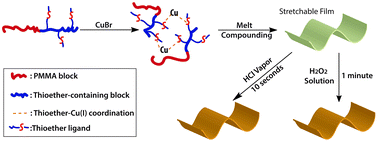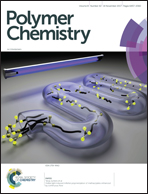Multifunctional polymers built on copper–thioether coordination†
Abstract
Copper(I)–thioether complexes have been extensively studied in the literature due to several qualities, including the diversity of coordination structures and the convenience and low-cost of preparation. In this work, acrylate-based block polymers containing thioether moieties were successfully coordinated with copper(I) to form thermally stable hybrid materials. The block polymer phase, poly(methyl methacrylate)-b-poly(methyl thioethyl acrylate-co-butyl acrylate) (PMMA-b-P(MTEA-co-BA)), was effectively reinforced by copper(I) bromide to give excellent mechanical performance (breaking strength of 7.5 MPa and breaking strain of 500%). Meanwhile, the hybrid materials were endowed with self-healing capability because of the copper–thioether coordination. Notably, the melt-compounded films of copper(I)–thioether block polymers exhibited a very fast response towards hydrochloric acid vapor, reflected as a color transition within 10 seconds upon exposure. Additionally, the hybrid polymers also responded rapidly to hydrogen peroxide solution (color change within 1 minute). These unique characteristics grant possibilities to the hybrid materials to be utilized as flexible and cheap sensors for hydrochloric acid and oxidants. Fundamentally, this study expands the territory of metal–thioether coordinated block polymers and also sheds light on the fabrication of multifunctional hybrid materials for smart device applications.



 Please wait while we load your content...
Please wait while we load your content...